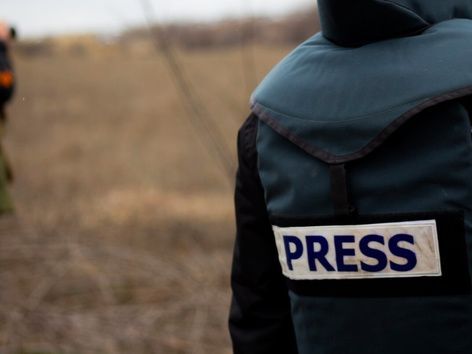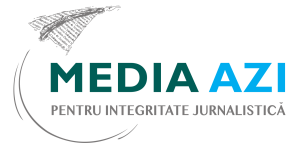Media stuck on traditional narratives about refugees

Steven Youngblood, 2023-24 Fulbright Scholar, Moldova
professor and director, Center for Global Peace Journalism, Park University (Missouri USA)
Of the many challenges for Moldova unleashed by Russia’s war in Ukraine, few loom larger than accommodating refugees.
Moldova currently houses more refugees per capita than any other country, according to the International Centre for Migration Policy Development. With a population of 2.6 million, the country is home to 119,000 refugees as of 3 October, 2023. Border crossings from Ukraine since 24 February 2022 number 952,819, according to UNHCR.
For humanitarian NGO’s and social service providers, the implications of this large influx are obvious. Equally challenging are the implications of mass migration for media houses and journalists. For journalists, the challenge is to break out of traditionally negative narratives about refugees, and offer compassionate counter-narratives that debunk negative stereotypes while building bridges between the refugees and their host communities.
Europe, refugees, and media
According to UNHCR, the number of forcibly displaced and stateless people in Europe rose to 21.8 million by the end of 2022, including almost 12.4 million refugees, 1.3 million asylum-seekers, 7.2 million internally displaced people (IDPs), and 474,000 who were stateless.
Traditional media in Europe and elsewhere often report about vulnerable migrants in a manner that is one-dimensional, negative, distorted, and sometimes even racist or xenophobic.
Journalist Cedvet Acu observes, “Mass media can either reinforce the ‘criminalised’ image of refugees, which leads to hate speech and hostility against refugees or, on the contrary, they may help to reduce the conflict between refugees and locals, which provides a peaceful environment for all.”
A number of studies have sought to examine the extent of anti-migrant bias and negativity by examining media coverage of the 2015 Syrian refugee “crisis.”
A Romanian content analysis study that looked at reporting about refugees found six news frames in 2015-16, accounting for 86% of all refugee narratives studied. “The six primary frames resulting from the cluster analysis of concept codes are as follows: (1) European crisis, (2) Securitization, (3) Context/victimization, (4) Relocation/distribution, (5) International conflict, and (6) Humanitarian/personalization,” the report said.
The report’s authors concluded, “The development of the most salient frames over the ten quarters of the analysis showed how public discourse in Romanian news media moved from the dominant European crisis to the context/victimization and securitization frames…as well as on control measures instituted to control the flow of refugees. In doing so, the local variations in frames follow the general European tendency toward securitization.”
The threat narrative can manifest itself as coverage that creates a “moral panic” about refugee “crises.” A 2017 report by the European Institute of the Mediterranean by Dina Matar noted media coverage that reflected “the use by political elites and media entities of ‘moral panic’ discourses to construct divisions and differentiations along lines of nationality, race, ethnicity, religion, gender or other modes of difference within national or international boundaries and in relation to migration.”
The use of the word “crisis” is one example of how media contribute to a “moral panic” that pits “us” vs. “them” (refugees). Matar observes, “In terms of the current refugee ‘crisis,’ it is not an exaggeration to say that media coverage of what has been termed the migration or ‘refugee crisis’ in Europe and elsewhere has followed similar trends, and has been as politically divisive and inconsistent as have official policies regarding the phenomenal increase in the number of people seeking refuge in Europe…What is worrying are the ways in which mainstream media coverage of the refugees or migrants in Europe and in the Middle East and North Africa have tended to repeat stereotypes and frames that construct the refugees as a collective ‘other’ that is different from ‘us,’ and as a humanitarian or security problem, and in the process silencing, dehumanizing. and marginalizing those represented and talked about.”
The language used to label refugees and other migrants is vitally important. As Matar notes, “the word refugee, often used interchangeably with the words migrant or asylum seeker, has been essentialized as a fixed and rigid category in which refugees have been delineated as those who are ‘worthy” or “unworthy,’ or those who qualify for protection and those who fail to qualify, or, in other words, those who deserve our compassion and sympathy or those whom we should be afraid of.”
In another study about the 2015 “crisis,” Cardiff University (UK) researchers examined reporting across five countries, Spain, Italy, Germany, the UK and Sweden. “Researchers…found major differences between countries, in terms of the sources journalists used (domestic politicians, foreign politicians, citizens, or NGOs), the language they employed, the reasons they gave for the rise in refugee flows, and the solutions they suggested. Germany and Sweden, for example, overwhelmingly used the terms ‘refugee’ or ‘asylum seeker’, while Italy and the UK press preferred the word ‘migrant’. In Spain, the dominant term was ‘immigrant’. These terms had an important impact on the tenor of each country’s debate. Media also differed widely in terms of the predominant themes to their coverage. For instance, humanitarian themes were more common in Italian coverage than in British, German or Spanish press. Threat themes (such as to the welfare system, or cultural threats) were the most prevalent in Italy, Spain and Britain. Overall, the Swedish press was the most positive towards refugees and migrants, while coverage in the United Kingdom was the most negative, and the most polarised.”
Comparing coverage of Syrian and Ukrainian refugees
A number of shocking examples illustrate what many media critics decry as xenophobia and racism when one compares coverage of these two refugee “crises.”
One recent article cited several examples:
–Kelly Cobiella, an NBC News correspondent based in London, said, “Just to put it bluntly, these are not refugees from Syria, these are refugees from neighbouring Ukraine. That, quite frankly, it is part of it. These are Christians, they are white, they’re… um… ‘very similar to the people that live in Poland’.
–Charlie D’Agata, CBS News foreign correspondent, reported, “This isn’t a place, with all due respect, like Iraq or Afghanistan … This is a relatively civilised, relatively European -I have to choose those words carefully too- city, where you wouldn’t expect that or hope that is going to happen.”
—BFM TV (France) journalist Philippe Corbé said, “We’re not talking here about Syrians fleeing the bombing of the Syrian regime backed by Putin. We’re talking about Europeans leaving in cars that look like ours to save their lives.”
–Daniel Hannan from the Daily Telegraph (UK) observed, “Ukraine is a European country. Its people watch Netflix and have Instagram accounts… War is no longer something visited upon impoverished and remote population.”
In terms of research, a 2023 qualitative and quantitative study done for the International Organization for Migration (IOM) examined English language media coverage about refugees during the so-called 2015 Syrian refugee “crisis” and the current situation with Ukrainian refugees.
The report notes, “The news media play an important role in shaping public opinion around who migrants and asylum-seekers are and the legal and moral responsibilities of destination countries. Media coverage frequently relies on and perpetuates common narratives around migrants, with sympathetic coverage highlighting asylum-seekers as victims of conflict and the benefits to destination communities arising from the integration of migrants, while negative coverage recites and expands upon themes of migrants as threats to the national security, cultural identity, economic security, and health of the destination community (Banulescu-Bogdan, 2022).”
As previously mentioned, the threat narrative is common in coverage of refugees (and migrants more generally) worldwide. The IOM study says, “References to migrants or refugees as any type of threat were 4.2 times more common in the 2015 sample than in the 2022 sample, with threats to national security accounting for the majority of references (71% for 2022; 64% for 2015) in both cases. In 2015, concerns regarding national security were closely linked to terrorism; media discussing the potential for asylum-seekers to be affiliates of terrorist organizations were common leading up to the November 2015 Paris attacks and ubiquitous in the months that followed. Conversely, despite 2022 seeing an aggressor on European soil, suggestions of threat – for example, that Russian operatives may be hidden among Ukrainian asylum-seekers – were limited primarily to tabloid coverage in the first weeks of the conflict.”
The quantitative segment of the IOM study confirms the qualitative findings that suggest “an ambivalence towards asylum-seekers and migrants in 2015 compared to the strong support of displaced Ukrainians in 2022.” Qualitatively, a content analysis found that “media in 2022 covered topics of support and integration (such as housing, community volunteering, or livelihoods) at much greater rates than did media in 2015, whereas 2015 saw high rates of coverage discussing border crossings and migrants as threats.”
In conclusion, the IOM study found interesting and potentially troubling differences in the ways that Syrian refugees in 2015 and Ukrainian refugees in 2022-23 were treated, noting “striking differences between the way that Ukrainian refugees have been covered and the way that refugees from Syria have. In both instances, civilians are fleeing the wholesale destruction of their homelands, at the hands of some of the same antagonists. However, differences in media portrayals of refugees – in terms of, among other things, perceptions of threat, refugee legitimacy, or economic contribution – have helped to delineate the landscape which refugees from Ukraine and Syria encountered in Europe in 2022 and in 2015.”
Conclusion
The concern about refugees in Europe is matched by worries about overwhelmingly negative media reporting about these refugees that reinforces stereotypes and portrays refugees as threats.
Better, productive media narratives around Ukrainian refugees are needed to, in the words of the IOM study, “sustain public support in the critical months ahead, as the war is prolonged and expectations around an early resolution and return diminish.”
In part two of my report on media and refugees (coming soon), I’ll offer a prescription for improved reporting about refugees using a peace journalism model that emphasizes balance and empathy, offers positive counter-narratives, and encourages the use of journalism to build bridges between refugees and their host communities.



